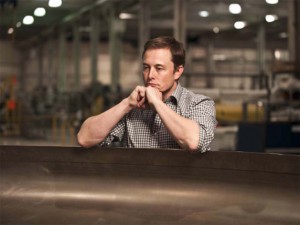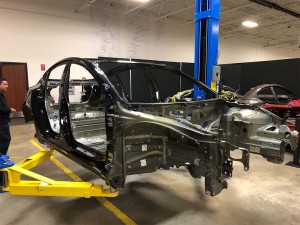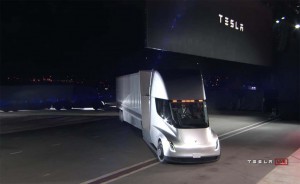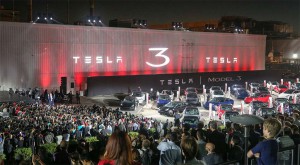
Tesla CEO Elon Musk has taken to sleeping at the Fremont plant hoping to drive improvements in quality and production levels.
Tesla managed to beat Wall Street expectation on Wednesday, even as it reported the biggest loss in the company’s history.
But revenues exceeded expectations and the loss was actually less than anticipated, while the Silicon Valley automaker noted that production of the critical Model 3 battery-sedan reached 2,270 in the week prior to a temporary shutdown of the Fremont, California assembly plant last month. That’s up from barely 2,000 at the end of the first quarter.
“The thing I’m most excited about is the rapid increase in output,” said Musk during a Wednesday afternoon conference call with analysts and reporters. “Production is improving dramatically, exponentially, in fact.”
That also applies to what is happening at Tesla’s Reno, Nevada Gigafactory which produces the batteries for the Model 3, as well as older Models S and X. At a peak, Musk noted that it has hit a peak that would average out to 5,000 battery packs a week.
(Does Tesla Semi live up to the hype? Click Here for more.)
Despite opening his comments by focusing on “very positive” developments, the Tesla numbers for the first quarter reflected the troubles the automaker has had with the Model 3, Musk last year warning that the automaker would be facing “production hell.”
The automaker actually saw its loss double to $784.6 million, or $4.19 a share –an all-time record — from $397.2 million, or $2.04 a share a year ago. But excluding special, one-time items, the loss narrowed to $3.35 a share, which was better than the $3.58 a share consensus estimate, according to Thomson Reuters.
Revenues, meanwhile, jumped to $3.41 billion, compared to the Wall Street consensus of $3.22 billion. The automaker’s burn rate narrowed, as well, according to analysts, but is still putting Tesla in a precarious position. The company said it had $2.7 billion in cash as it closed the quarter, down from around $3.5 billion at the end of 2018. That was slightly better than the $2 billion in cash estimated by Moody’s which downgraded Tesla in April, but still on a downward trend.
(What’s really under the skin of the Tesla Model 3? Click Here to find out.)
One of the key questions is whether Tesla will be able to drive up revenues by boosting production fast enough to avoid having to go back to the equity market. Musk has said there is no need to raise additional capital in 2018, and pressed during the call said, “I specifically don’t want to. But speculation has still fueled a significant growth in short-selling.
Investors, however, drove up TSLA shares after the carmaker released its Q1 numbers and Musk further aimed to buoy the positive response when he reiterated recent promises to have Tesla in the black by the second half of this year.

A recent tear-down of the Model S revealed a state-of-the-art electric drive system, according to Munro & Associates, but major problems with the sedan's body.
“I am definitely confident about achieving positive income and cash flow,” he said in his opening remarks, Musk stressing that he is working “to make sure we are well set up to achieve that goal.” But he also acknowledged there are “barnacles upon barnacles” that first need to be addressed.
Continuing to drive up Model 3 production is the toughest barnacle, according to analysts. Fremont was expected to reach 2,500 vehicles a week by the end of the first quarter but managed only about 2,000. But Musk said that jumped to 2,270 in the week before a temporary shutdown at Fremont in April.
Some of that has come from finding ways to simplify the manufacturing process. The South African-born entrepreneur pointed to an unnecessary bit of “fluff” removed from the battery pack, as well as a piece on the Model 3 sedan’s front suspension. Musk has also backed away from his original goal of automating every possible operation along the Gigafactory and Fremont lines.
Some operations “are poorly suited to robotics,” he acknowledged.
“It looks like Elon’s all-nighters at the factory are paying off, because Tesla seems to be finally getting some momentum,” said Jessica Caldwell, a senior analyst with tracking firm Edmunds. “Tesla showed signs of picking up steam in April, which bodes well for the company’s prospects this year.”

Tesla has been sued by a rival developing a hydrogen powered truck claiming Tesla has stolen its patents.
The question is whether a company that has repeatedly missed its targets will get to the 6,000-a-week mark that Musk says he wants by around the end of the second quarter of this year. With more than 400,000 advance reservations on hand, it now seems unlikely that all will be filled until well into 2019, according to analysts. And there have been numerous reports that potential customers are asking for their $1,000 deposits back and shopping for alternatives, such as the battery-electric Chevrolet Bolt EV.
Over the next 12 months alone there will be an array of new, long-range models rolling into U.S. showrooms, including two more from General Motors, as well as offerings from Volkswagen, Porsche, Audi, Jaguar and other competitors.
But Musk insisted, “I feel very confident about our ability to get to 5k (5,000 Model 3s) very soon.” At that point, he explained, Tesla will begin to invest in the equipment needed to boost its output to the original goal of 10,000 vehicles a week – which would also include the older Models S and X.
Once that happens, he said, Tesla could wind up minting money. Asked if he still sees a possibility of hitting 20% margins this year, Musk said, “Q4 is when we expect 20%, and by the middle of next year 25 percent. And we’ll try to get to high 20s by the end of next year.”
If he’s right, that would provide much-needed cash for the next wave of products Tesla is planning. Musk said he expects a major ramp-up of spending on the Model Y, the SUV alternative to the Model 3, in 2018. Tesla also has to get to work on the electric Semi truck it is developing, as well as a battery-powered pickup.
During his conference call, the charismatic Musk worked overtime to put a positive spin on Tesla’s first-quarter loss. But there were plenty of other issues beyond Model 3 production that could create headaches for Tesla going forward.
On Tuesday it was hit with a lawsuit filed by Nikola Motors – a company that also based its name on legendary inventor Nikola Tesla. The Salt Lake City-based firm is hoping to launch production in 2019 of a long-range semi truck powered by hydrogen fuel cells.
(For more on the Nikola-Tesla lawsuit, Click Here.)
That technology has frequently been dismissed by Tesla CEO Musk as “fool cells.” Instead, he has ordered up the development of a new battery-powered Semi model set to launch about the same time. But in its suit, Nikola claims its Silicon Valley rival “copied Nikola’s (design) patents,” for such things as a wraparound window and mid-mount doors. In its filing, it said it, “estimates its harm from Tesla’s infringement to be in excess of $2 billion.”
For its part, Tesla issued a statement stating, “It’s patently obvious there is no merit to this lawsuit.” But the case could consume cash, time and energy, even if the EV maker ultimately prevails.
And there are plenty of other issues, ranging from a federal investigation into the fatal crash of a Tesla Model X operating in semi-autonomous Autopilot mode to an NLRB probe of a mass firing at the Fremont plant critics charge was really meant to get rid of workers trying to unionize the factory.
The bottom line for Tesla is that it still has plenty of challenges ahead and while it is showing progress, it is far from out of trouble.

